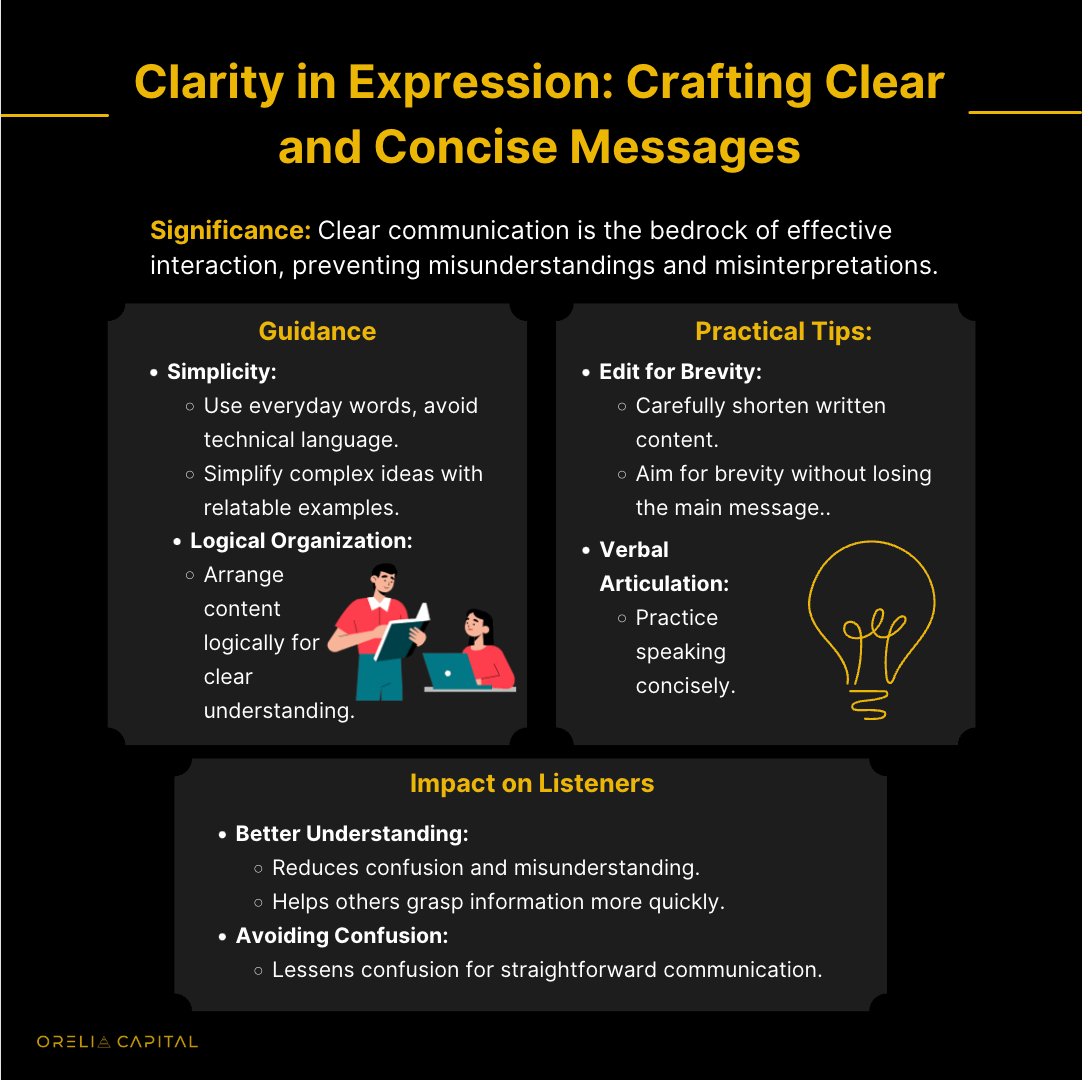The Art of Communication

Communication is a game-changer in our daily lives, influencing how we connect with others. In this article, we'll break down key aspects to sharpen your communication skills. From active listening to clear expression, nonverbal cues, adapting styles, and conflict resolution – each piece contributes to the art of effective communication. Let's dive in and unlock the power of understanding, clarity, and successful interactions.
Active Listening: The Foundation of Effective Communication
Importance:
- Active listening is the cornerstone of effective communication.
- It goes beyond hearing; it involves fully engaging with the speaker.
Tips for Better Listening:
- Maintain Eye Contact: Establishes a connection and shows attentiveness.
- Avoid Interruptions: Allow the speaker to express themselves fully before responding.
- Ask Clarifying Questions: Demonstrates interest and ensures a clear understanding.
Impact on Relationships:
Builds Trust and Rapport:
- People feel valued when their words are genuinely heard.
- Strengthens the foundation of relationships.
Fosters Mutual Understanding:
- Reduces the likelihood of miscommunication and misunderstandings.
- Encourages a collaborative and harmonious environment.

Nonverbal Communication: The Unspoken Language
Role of Nonverbal Cues:
- Nonverbal communication complements verbal messages, adding depth and nuance to the overall understanding.
- It is a powerful tool for conveying emotions, attitudes, and intentions without relying solely on words.
Types of Nonverbal Cues:
- Body Language: Posture, gestures, and movements communicate a wealth of information. For instance, open body language signifies receptiveness, while crossed arms may indicate defensiveness.
- Facial Expressions: Facial cues, including smiles, frowns, and raised eyebrows, provide immediate insights into someone's emotional state.
- Gestures: Hand movements and gestures can emphasize or clarify spoken words, facilitating a more comprehensive communication experience.
Aligning Nonverbal Cues with Verbal Communication:
- Consistency between verbal and nonverbal cues reinforces the message's authenticity. Mixed signals can lead to confusion and misinterpretation.
- Adjust nonverbal cues based on the context. A formal presentation may require more controlled gestures, while casual conversations allow for a more relaxed demeanour.
Cultural Sensitivity in Nonverbal Communication:
- Different cultures may interpret nonverbal cues differently. Awareness of cultural nuances is essential to avoid misunderstandings.
- For example, maintaining eye contact may signify attentiveness in some cultures but can be perceived as aggressive in others.
Impact on Relationships and Impressions:
- Nonverbal communication significantly influences first impressions. A firm handshake, genuine smile, and good posture convey confidence and trustworthiness.
- In relationships, nonverbal cues play a crucial role in building rapport. Mirroring gestures and expressions can create a sense of connection.
Adapting Communication Styles: Tailoring Your Message to Your Audience
Adaptation Concept:
- Tailoring Communication: Customize your message based on the characteristics and preferences of your audience.
- Flexibility: Be adaptable in your tone, language, and style to resonate with diverse individuals and groups.
Importance:
- Enhanced Understanding: Adjusting communication styles ensures your message is more easily comprehended.
- Receptiveness: A tailored approach promotes greater receptiveness among listeners, fostering a positive communication environment.
Audience Considerations:
- Demographics: Recognize variations in age, gender, educational background, and other demographic factors.
- Cultural Nuances: Be mindful of cultural differences and adapt communication to respect diverse cultural norms.
- Individual Preferences: Consider individual preferences and communication styles, acknowledging that not everyone receives information the same way.
Examples:
- Adjusting Formality: Gauge the formality of your communication based on the context, whether it's a professional setting or a more casual interaction.
- Language Choices: Tailor your language to match the level of familiarity and understanding of your audience, avoiding unnecessary jargon or overly simplistic terms.
- Visual Aids: Recognize the preference for visual or auditory learning and incorporate appropriate visual aids or verbal explanations.
Benefits:
- Minimized Misunderstandings: Adapting communication styles reduces the risk of misunderstandings, ensuring that your message is received as intended.
- Increased Engagement: Tailored communication captures the interest and engagement of your audience, making the interaction more impactful.
Conflict Resolution: Navigating Challenges Through Effective Communication
Communication's Crucial Role:
- Understanding Perspectives: Effective communication allows individuals to comprehend diverse viewpoints, fostering empathy and openness.
- Facilitating Dialogue: Clear and constructive communication sets the stage for open discussions, enabling parties to express concerns and aspirations.
Strategies for Positive Conversations:
- Maintaining Calm: Emotions can escalate conflicts. Encourage a calm demeanour to create a conducive environment for resolution.
- "I" Statements: Encourage using "I" statements to express personal feelings without placing blame. This promotes accountability and shared responsibility.
- Seeking Compromise: Emphasize the importance of finding common ground. Encourage parties to identify mutually agreeable solutions that address underlying concerns.
Long-Term Benefits of Effective Communication:
- Strengthened Relationships: Successful conflict resolution builds trust and maintains relationships, fostering a more positive and collaborative environment.
- Improved Team Dynamics: In professional settings, mastering communication skills in conflict resolution contributes to a more harmonious and productive team.
In wrapping up, remember that good communication is like a secret weapon. We've covered listening well, speaking clearly, using body language, adapting to who you're talking to, and even turning conflicts into something positive. Think of it as painting a picture with understanding, clarity, and teamwork. These skills will make your connections more robust, whether you're chatting with friends, family, or people from different backgrounds. So, go out there and ace your communication game!

We hope you enjoyed this edition of our newsletter. If you found it helpful, please consider sharing it with others who might benefit from this information.
At Orelia Capital, we believe that feedback is a gift. Your feedback can help us improve our content and provide more value to our readers.





